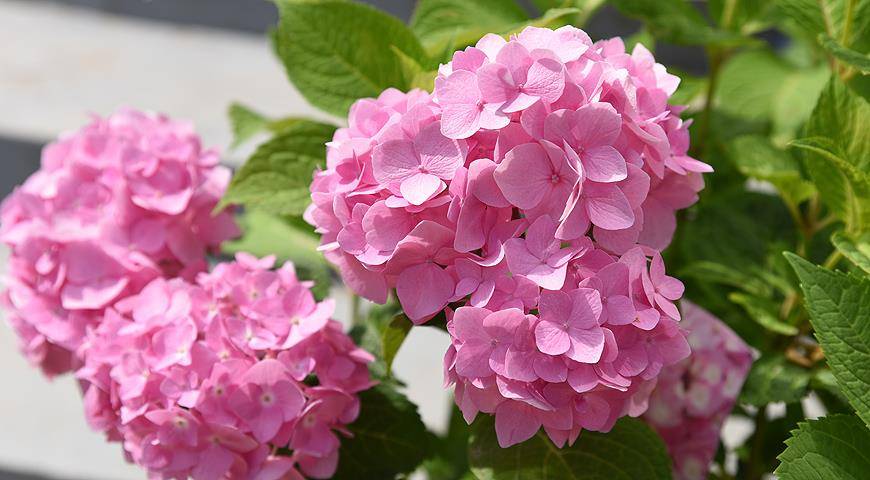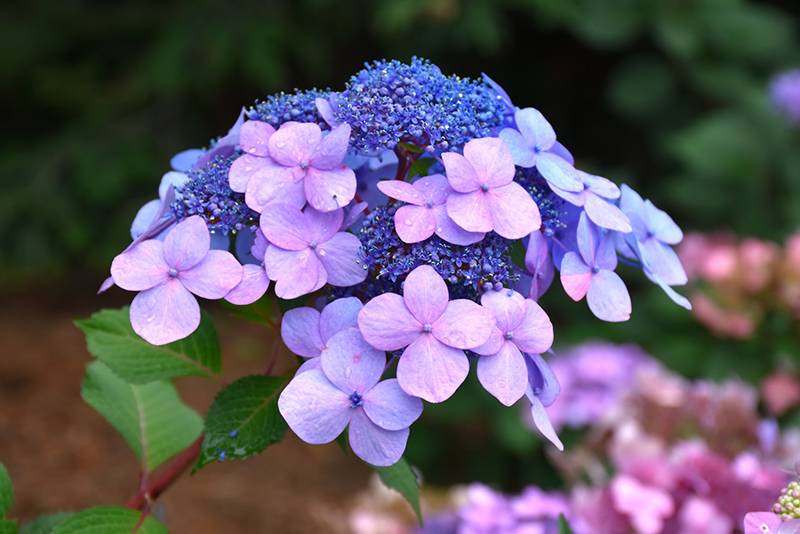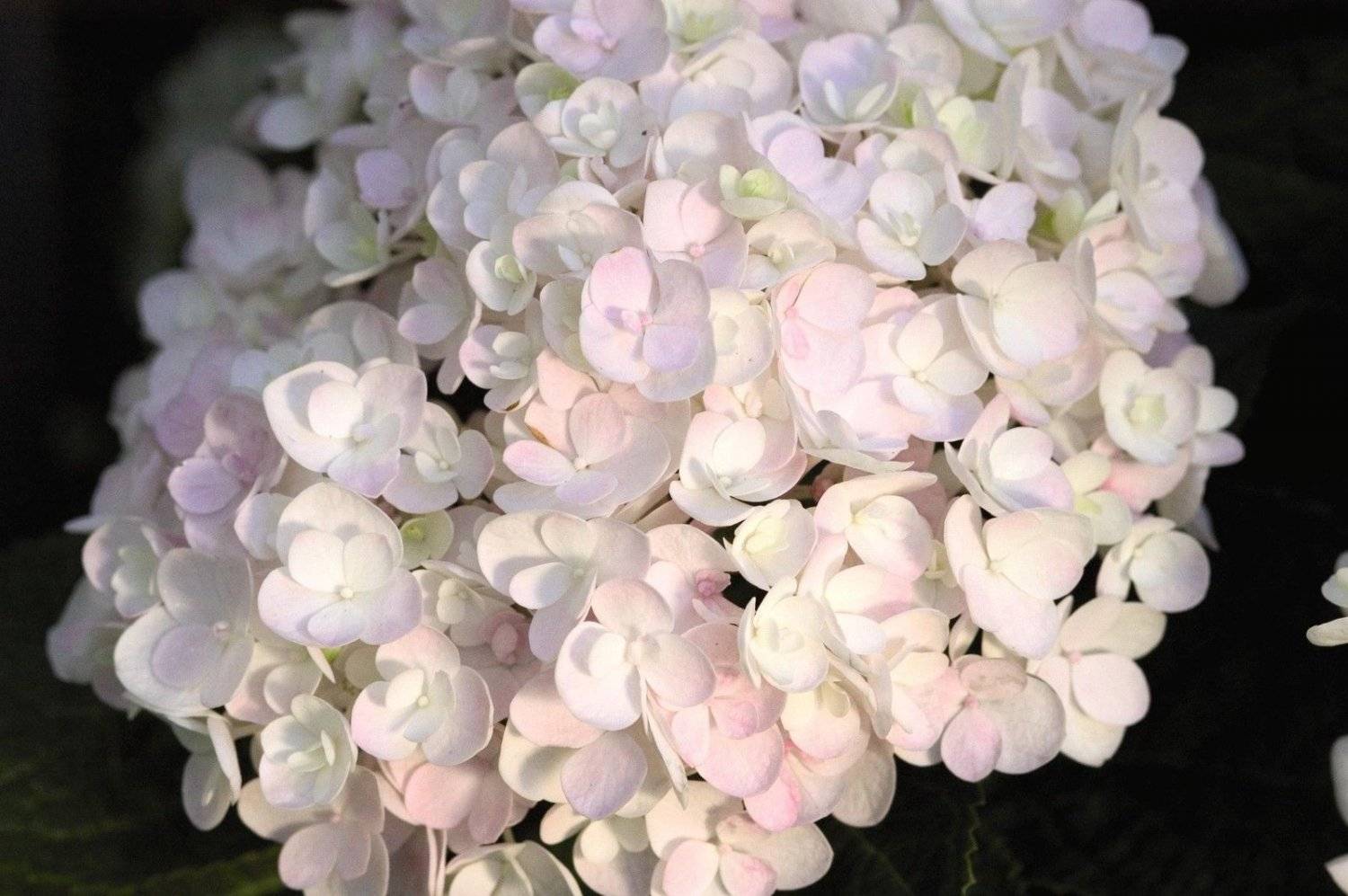Large-leaved hydrangea blooming on the shoots of the current year
Content:
Large-leaved hydrangea is the most demanding of all types of hydrangeas: it needs special soil, winter shelter and pruning. But despite this, gardeners appreciate it for the brightness and variety of flowers and leaves. This plant is pleasing to the eye and can beautify any garden, greenhouse or even a small courtyard.
The origin and appearance of large-leaved hydrangeas
Initially, the shrubs of the Hortensiev family were brought for the wealthy townspeople of England and France back in the 16th century. Then the hydrangea had only two colors: red and white. It fell in love with gardeners for its large and bright inflorescences and the ability to bloom profusely even in the shade, so various types of this plant quickly began to appear: tree, paniculate, petiolate, serrate, radiant and many others.
One of the most popular is the large-leaved hydrangea (Hydrángea Macrophýlla). It is a perennial ornamental shrub that has straight stems and grows up to 2 m in height. It has no fruit, the color of the flowers is pink, blue, purple or white.
Flowering features
The color of broadleaf hydrangeas depends on the acidity of the soil: blue flowers bloom on acidic soils containing a lot of aluminum, and pink flowers turn on soils close to neutral. Another difference between this shrub is the complete absence of aroma, so it can be grown even for allergy sufferers.
On which shoots does large-leaved hydrangea bloom
By nature, hydrangea could only bloom on last year's shoots, which created certain difficulties for gardeners, since it is difficult to maintain shoots and buds throughout the winter. At the end of the last century, to the delight of lovers of these shrubs, a large-leaved hydrangea appeared, blooming on the shoots of the current year. This expanded the geography of the use of the shrub, now it is possible to grow it in regions with a temperate climate.
Many novice gardeners are also interested in the question on which shoots the panicle hydrangea blooms. This plant also blooms on the shoots of the current year, so the care, pruning and growing of the shrub will be similar to caring for the tree hydrangea.
Frost resistance
Initially, this shrub was grown in Europe as a greenhouse and ornamental plant, but today, thanks to the efforts of breeders, large-leaved hydrangea has acquired frost resistance. But it should be borne in mind that this shrub comes from China and Japan, where the winters are milder, therefore, in the conditions of harsh Russian winters with severe frosts and prolonged thaws, it is better to wrap the plant for the winter.
Colds are especially dangerous for hydrangeas blooming on the shoots of last year: one frost is enough, and the flower bud will die, making it impossible to enjoy the summer flowering of this shrub.
Types and varieties of large-leaved hydrangeas
There are many types of hydrangeas that are resistant to cold and original appearance. Despite all the variety of varieties, large-leaved hydrangeas have three types of inflorescences: spherical, hemispherical or umbellate. The petals are distinguished by a wide variety of shapes: serrated, corrugated, wavy, terry. Even varieties with variegated leaves have appeared.
A distinctive feature of these shrubs is the variety of color shades, even within the same plant, the color of the inflorescences can change depending on the properties of the soil, weather or the quality of water for irrigation. But, despite all the diversity, all varieties of large-leaved macrophiles are divided into two large groups: ordinary and remontant.
Repairing varieties of large-leaved hydrangea
The large-leaved repairing varieties of hydrangea were bred by breeders relatively recently, about 40 years ago, and in Russia they appeared on sale at the beginning of the 21st century. Due to the fact that they can bloom both on last year's shoots and on the branches of the current year, these varieties are distinguished by stable flowering regardless of weather conditions.
This feature also gives the plant increased winter hardiness: even if last year's bud freezes, it will still bloom in the spring due to new shoots. Therefore, in warm regions of Russia, a large-leaved remontant hydrangea is able to winter even without shelter (although experts recommend insulating a flower for the winter in any case). But in Siberia, with its cold winters, tree varieties, even remontant ones, can only be planted in summer.
New varieties of hydrangeas are constantly appearing on sale, remontant ones can be distinguished from the whole variety of species by markings on the labels: "RE", "Persistant" or "Everyblooming".
- Endless Summer (Endless Summer). The most famous variety of winter-hardy hydrangea, which was the first to enter Russia and immediately fell in love with gardeners. Although its flowering is not original and has the usual small spherical inflorescences, this remontant hydrangea is the ancestor of all varieties that can bloom on young shoots. The bush got its name Endless Summer due to the constant renewal of flowers during the entire warm period. Another advantage of the variety is good frost resistance: frosts down to -29 ° C are not capable of harming the bush.
- Twist-n-Shout. Twist and Shout is an original flower from a new series of varieties Everlasting Summer. It differs in flat inflorescences with two types of flowers: small, bead-like, located in the center, surrounded by large four-petal flowers around the perimeter. The leaves are large, in autumn they become burgundy. The shrub is frost-resistant, tolerates temperatures down to -30 ° C without any problems. It blooms throughout the warm season; in the eastern part of Russia, two peaks of flowering are possible - at the beginning and at the end of summer.
- Blushing Bride. A new and very cute variety from the same series, its name translates as "shy bride". Blushing Bride's petals are round in shape, the buds are white in color, and subsequently, when the plant begins to bloom, acquire a pinkish blush, as if painted by the setting sun.
Hydrangea varieties blooming on the shoots of the current year
Breeding work does not stand still, and the list of hydrangeas that bloom from a spring flower bud is already not limited to the Endless Summer series, but has hundreds of different varieties that are also winter-hardy. The most interesting of them are presented below.
- Passion. Passion is a variety with large spherical, bright pink inflorescences. Belongs to the You & Me series, which is distinguished by its amazing winter hardiness and ease of maintenance.It is enough just to cover it for the winter, and the plant will feel great and bloom for a long time even in the suburbs with its cool climate.
- Freepon. One of the new varieties. It can bloom both on the shoots of the current and last year. Fripon differs from others in strong stems and original corrugated edges of the petals, the main color is from blue to blue. Flowering continues until the first frost. A fairly frost-resistant variety, it should be covered no earlier than the temperature drops to -18 ° C. The bright petals of macrophiles are actually overgrown sepals that are needed to attract insects, they remain on the branches for a long time. And real small flowers are more modestly colored, they lose their petals after setting the seeds.
- Green Shadows. A distinctive feature of Green Shadows is an interesting color of flowers: bright light green in the center, towards the edges they become red-burgundy. The petals are triangular, pointed. Long-lasting flowering, bright inflorescences do not fade even in autumn. Dense bush of strict shape up to 1 m high.
Non-remontant varieties
Varieties that bloom on last year's shoots require special care. So that they can bloom in spring and delight the eye with their original inflorescences, they must be covered for the winter with a standard shelter, about the same as for roses.
- Hopcorn. Belongs to the Hovaria series. It got its name from the similarity of rounded petals to popcorn - popcorn. At the first stage of blooming, the flowers have a light green color, later the color changes to violet-blue or pink. The uneven color combination on one shrub creates a stunning effect, which is complemented by the velvety relief of the petals.
- Hamburg. Hamburg is a charming variety with dense, globular buds. The flower petals have fringed edges. On the same plant, there can be both pink and blue inflorescences at the same time. Strong, round bush about a meter high. Leaves are dense, brightly colored. For the winter, Hamburg is covered to protect the flower buds from freezing.
Large-leaved hydrangea has gained well-deserved popularity due to its lush inflorescences, a variety of species and colors, and the possibility of flowering even in the shade. This plant provides ample opportunities for landscape gardening, therefore it is one of the most common ornamental shrubs.













